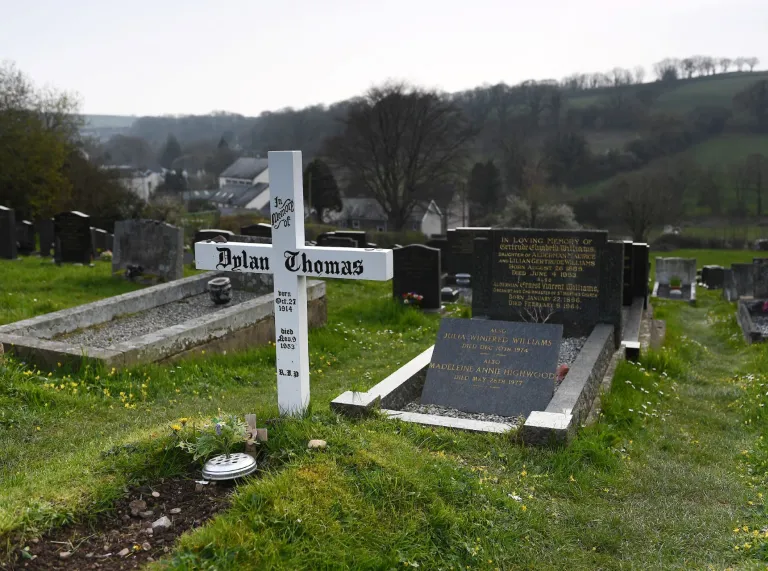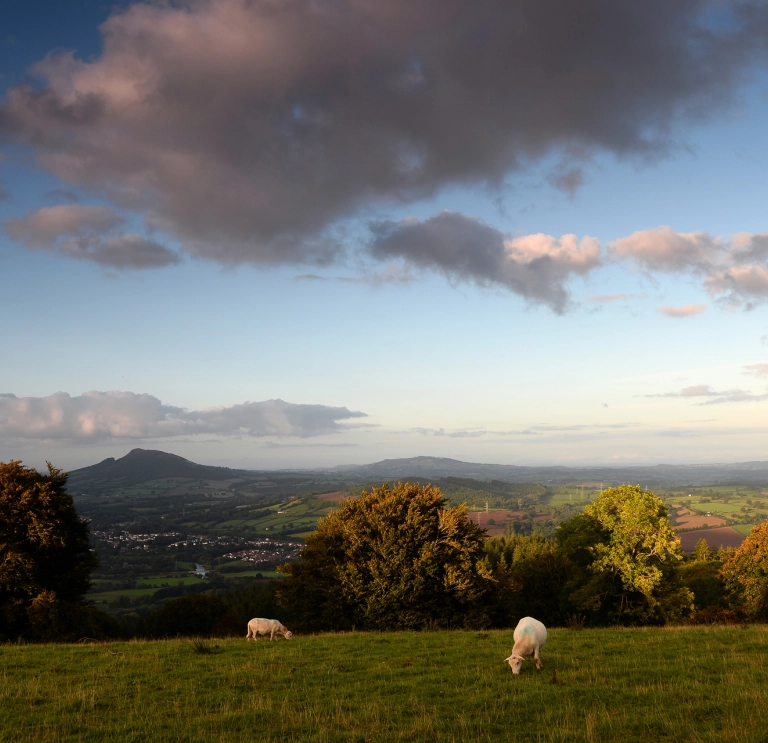There is something in Wales that inspires. Perhaps it is the labyrinth of mines under the mountains, the cloud-wrapped summits, or trickling valley streams. Here is a place where language, tradition and landscape are connected to a lost and ancient past.
Roald Dahl
Born in Llandaff, Cardiff to Norwegian parents, Roald Dahl (1916-1990) has sold more than 300 million books worldwide. Dahl’s Oslo-born father, Harald, came to the Welsh capital to seek his fortune in the late 19th century iron and coal boom. Roald was born at the family home, Villa Marie, which is marked by a blue plaque on the garden wall. He went to the Cathedral School in Llandaff, situated in the shadow of the towering Gothic Llandaff Cathedral.
The family attended the Norwegian Church, and the young Roald was christened here in 1916. Today the Norwegian Church is an arts centre, and the nearby Oval Basin in Cardiff Bay has been reverentially renamed Roald Dahl Plass. The Dahl family holidayed each Easter in Tenby, a tradition that Dahl continued with his own children. Dahl also spent time in Laugharne, Carmarthenshire, where he visited Dylan Thomas’s writing shed on the estuary – and was inspired to build his own writing hut at his home in Buckinghamshire. There’s plenty more to discover about Dahl’s Welsh connections.
Incidentally, Cardiff has also produced the first woman to win the Booker Prize – Bernice Rubens, whose The Elected Member won in 1970. Trezzo Azzopardi’s The Hiding Place was also Booker-nominated in 2000. Like Dahl, both women were the children of migrants – Lithuanian Jewish and Maltese respectively – who made Cardiff Bay (or Tiger Bay, as it was then known) the UK’s first multicultural society.



Dylan Thomas
The poet Dylan Thomas is most strongly associated with Swansea, where he was born in 1914, and Laugharne, where he was buried just 39 years later. In between, he blazed a literary trail that influenced a generation of poets.
The best place to start is the Dylan Thomas Centre, which has a permanent exhibition on Dylan, and runs literary events throughout the year. The centre has also devised a series of trail guides that are packed with anecdotes on his life, following Dylan’s footsteps from his birthplace in Cwmdonkin Drive, out into the Carmarthenshire countryside, and up to New Quay, where Dylan lived for a year during the Second World War. New Quay helped to inspire Dylan’s ‘play for voices’, Under Milk Wood; the 1972 film version, starring Richard Burton and Elizabeth Taylor, was filmed in nearby Fishguard.
Dylan’s final years were spent in Laugharne, where he lived in a boathouse down on the estuary. He’s not the only literary figure to have been beguiled by Laugharne’s charms: the poet Edward Thomas lived here, as did High Wind in Jamaica author Richard Hughes, while Margaret Atwood’s short story The Grave Of The Famous Poet is set in the town. The great feminist philosopher Mary Wollstonecraft lived here, and her daughter Mary Shelley, who wrote Frankenstein, often visited. Today, the town hosts the cult Laugharne Weekend festival.
A few other Swansea literary connections of note: Dylan Thomas was part of the ‘Kardomah Gang’ of poets, artists and composers – including Vernon Watkins, Daniel Jones and Alfred Janes – who met at the Kardomah café. The novelist Kingsley Amis worked as an English lecturer at Swansea University in the 1950s, and wrote much of his 1986 Booker Prize-winning novel The Old Devils in Laugharne.


RS Thomas
Although less well-known than his namesake Dylan, many regard Ronald Stuart Thomas – RS – as the greatest Welsh poet of the 20th century. RS Thomas was born in Cardiff in 1913, and never quite forgave his parents for bringing him up to speak English: he only learnt Welsh in his 30s – too late, he lamented, to be able to write poetry in Welsh.
The rest of his life was a gradual pilgrimage north and west, working as a country curate in rural parishes where he could live and work through the Welsh language. He started in St Mary's Church in Chirk, then to Manafon near Welshpool, and on to Eglwys-fach on the west coast. He loved bird-watching at the RSPB Ynys-hir Nature Reserve… although the ascetic priest would have taken a dim view of the village’s luxurious, award-winning Ynyshir Restaurant and Rooms. By then he was a passionate, even violent, advocate for Welsh identity, infamously supporting the fire-bombing of English-owned holiday cottages.
His final move was to the parish of Aberdaron, where he finally found the wild Welshness he craved. Nobody would describe RS as the easiest man (his family certainly didn’t). But read the poems: they’re among the most starkly beautiful in the English language.


Owen Sheers
The poet Owen Sheers grew up in Abergavenny, and much of his earlier poetry conjures up the majestic landscape of the Black Mountains, which straddle the border between Powys and Herefordshire. His hit novel/film Resistance was also set among these green folds (as was Bruce Chatwin’s On the Black Hill). Sheers’ astonishing reworking of The Passion, starring Michael Sheen, took over an entire town - Port Talbot – as its stage in 2011, and his 2016 film-poem The Green Hollow was a heart-breaking tribute to the survivors of the Aberfan disaster.



Dafydd ap Gwilym
One of the greatest medieval European poets, Dafydd ap Gwilym (14th century) was born into a noble family in the parish of Llanbadarn, just inland from Aberystwyth. His poetry brims with vibrancy, vigour and local references: one describes how he ogles Llanbadarn girls in church. In fact, love and sex were regular themes; a few of his works are so joyously filthy that they have only recently been included in collections.
He died around 1350; both Strata Florida Abbey in Ceredigion and Talley Abbey in Carmarthenshire claim to be his burial place. The National Library of Wales in Aberystwyth is the best place to find out more – among its treasures are the Hendregadredd Manuscript, which has a copy of one of Dafydd’s poems that’s believed to be written in his own hand.
More recently, novelist Malcolm Pryce has created an entirely new genre of literature – Aberystwyth Noir – and the town’s also home to novelist Niall Griffiths, and has inspired the work of novelist/singer Fflur Dafydd.


Hedd Wyn
The soldier-poet Ellis Evans – better known by his bardic name, Hedd Wyn – is a major figure in Welsh cultural life. He was killed in action at Passchendaele just weeks before he was due to be awarded top honours at the 1917 National Eisteddfod. The poet’s family farm, Yr Ysgwrn, near Trawsfynydd, is now a visitor centre with exhibitions about his life and legacy, Welsh language and culture, the bardic tradition, rural history, and the First World War. It’s also, handily, in the middle of the Eryri (Snowdonia) National Park.
Kate Roberts
The South Wales coalfields attracted thousands of migrant workers, but the North Wales slate mines were almost exclusively worked by Welsh-speaking local men, which had a major influence on cultural life. Yet it was a woman – Kate Roberts (1891-1985) – who was the greatest chronicler of the lives of men, women and children in the slate-producing north. The daughter of a quarryman, Roberts was raised near Caernarfon, and was hailed as ‘Brenhines ein Llên’: the ‘Queen of our Literature’. Her family home, a quarryman’s cottage called Cae’r Gors, has been restored to the way it would have been during her childhood. Other writers – notably T Rowland Hughes – set fictional work in the slate villages, and the 1935 film Y Chwarelwr (The Quarryman) was the first Welsh-language ‘talkie’. You can learn all about the industry at our National Slate Museum.


Richard Llewellyn… and others
As millions of tons of coal were hewn from the coal-mining South Wales Valleys, millions of words – mostly in English – were written about it. The poet Idris Davies (The Bells of Rhymney), firebrand union leader Lewis Jones (Cwmardy) and Cwmaman-born poet Alun Lewis (1915-1944) are among the most authentic voices.
Richard Llewellyn’s How Green Was My Valley is probably the most famous, thanks to a 1941 film adaptation which beat Citizen Kane to the Oscar for best film. Llewellyn hadn’t actually lived the life he described so vividly: born in England, he based his novel on occasional visits to his grandfather, a miner in Gilfach Goch.
Another novelist, Alexander Cordell, wasn’t born (and didn’t live) in the South Wales Valleys either, but mined a rich seam of coal-themed epics, starting with Rape of the Fair Country (1959). Ultimately, perhaps the most influential South Wales Valleys novel was written by a Scottish doctor, AJ Cronin. His novel The Citadel (1937), based on his experiences at the Tredegar Medical Aid Society, helped lay the foundation of the National Health Service. To put everything into context, you’ll want to visit the Big Pit National Coal Museum at Blaenavon.
Have a look on Wales.com to find out more about the literary greats of Wales.





